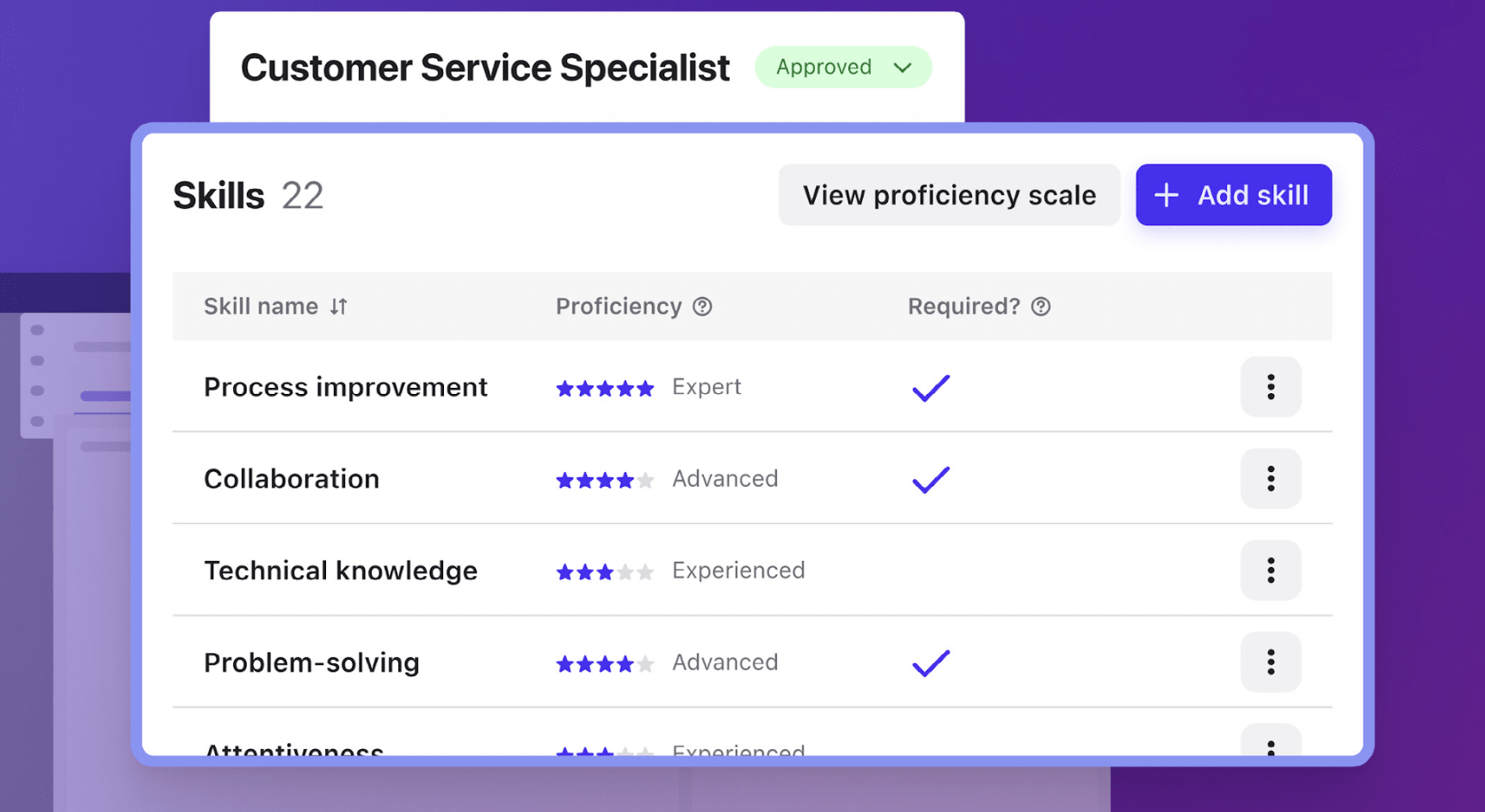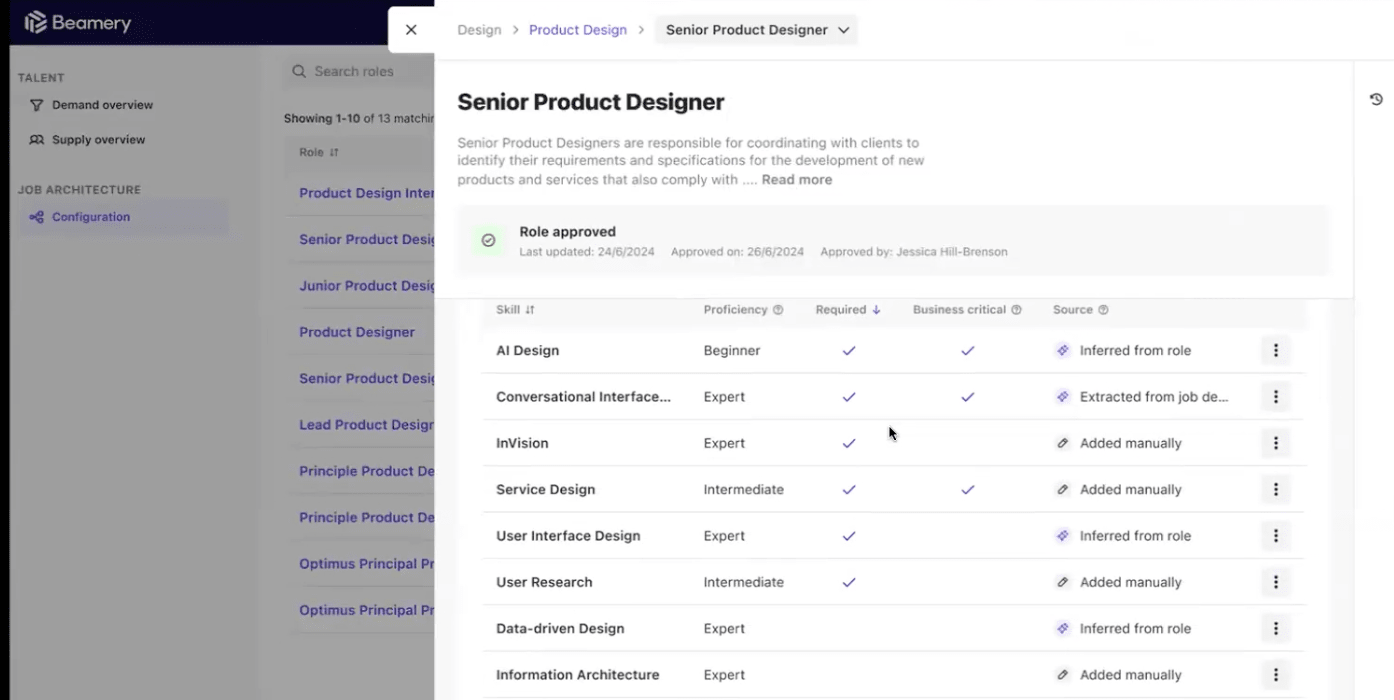Widen Your Talent Pool, Improve Diversity, & Close Skills Gaps
HR leaders are under pressure. They face widening skills gaps, due to technological developments and rapidly changing workforce requirements, making it harder than ever to find and hire the right talent. At the same time, particularly in the US but also in the UK, they face a looming question over the place of DE&I – forcing them to rethink how they create diverse, high-performing teams.
How can you widen and diversify your talent pool, and reduce bias in hiring, internal mobility and upskilling, while not relying on protected characteristics to make decisions?
The key is to adopt a skills-based approach, powered by ethical AI.
By moving beyond traditional hiring methods that prioritize degrees and job titles, companies can foster a more equitable process that assesses candidates based on their abilities and potential. The shift can help reduce the impact of unconscious bias, ensuring that talent from diverse backgrounds has equal opportunities, while broadening the talent pool – and making it far easier to match candidates to relevant roles at the right time.
The Changing DE&I Landscape 👀
Nearly 70 anti-DEI cases have been filed since 2024, according to a tracking database compiled by NYU School of Law. New presidential directives have instructed federal agencies to shape plans to “deter diversity, equity and inclusion measures” in the private sector. HR leaders are asking themselves how they can build high-performing teams and fill skills gaps – things that rely on wide, diverse talent pools – while not falling foul of existing or potential rules.
Gartner research finds that in a diverse workforce performance improves by 12%, and intent to stay by 20%.
Some states have already landed on the solution. In Colorado, for example, every agency and state department has a mandate to implement skills-based hiring practices (and also apprenticeship and other work-based learning programs) to help fill key roles. Their 2022 executive order states: “Skills-based hiring reduces potential barriers for applicants by providing a clear and specific description of skills required for each position which can be acquired through education, training, or past experience.”
As reported in Newsweek, “By removing degree requirements, determining the combination of skills required for success in the job and developing skills assessments, employers can find better candidates, make better-fit hires and diversify their ranks.”
The Benefits Of A Skills-Based Approach 💗
By removing rigid requirements like specific degrees or work experience, businesses can tap into talent from previously untapped sources – especially crucial in the current tight labor market, where nearly 83% of human resources leaders say they struggle to find enough talent with the necessary skills.
Talent pools can expand by up to 19x under a skills-first approach, which enables businesses to tap into a broader pool of candidates – people who may lack traditional qualifications, but have the skills necessary to excel.

Moreover, skills-based hiring is five times more predictive of job performance than hiring based on education and more than twice as predictive as hiring based on work experience. Prioritizing skills makes for better, more accurate hiring decisions – and improved workforce performance.
The approach also improves retention by promoting internal mobility and career growth based on skills development. Skills-based organizations are 98% more likely to have a reputation as a place to grow and develop and 98% more likely to retain high performers, according to research by Deloitte. Skills-based hiring ensures that the right people are placed in the right roles, enhancing job satisfaction and long-term engagement.
Embracing A Skills-Based Approach 🫱🏼🫲🏽
Adopting a skills-based approach means rethinking how we view both talent and jobs. It focuses on the specific skills and tasks needed to drive success, leveraging connected data and technology to identify gaps and opportunities. Additionally, there’s a renewed focus on upskilling, reskilling, and talent mobility to ensure continuous development across the workforce.
This approach doesn’t compromise on standards; instead, it expands the candidate pool while maintaining quality.
As new technologies and market demands evolve, companies need employees with dynamic and adaptable skill sets – so they need a dynamic and adaptable approach to workforce planning.
According to Korn Ferry, nearly 40% of TA professionals acknowledge the value of skills-based hiring – yet only 17% feel ready to implement it. So how do you get started with a skills-based approach?
The Importance Of Data: Skills Intelligence 📊
Once you have the right stakeholders engaged in the project, you need to build the right data foundations.
This means looking at tasks and talent through the lens of skills, creating skills-based talent profiles and skills-based job descriptions, and building a connection between them to match people efficiently and with precision.

One tricky element is creating and managing your skills taxonomy. How do you ensure each “skill” means the same thing, whether referring to a person or a role? How do you make sure the definitions are relevant to your organization and not generic? And how do you keep this up to date as things change?
Another thing to consider is the “interoperability” of skills data. Do your HR tech systems speak to each other? Is there a single source of truth for skills in your organization? And, again, does your skills data represent the latest information in terms of what talent is capable of, what roles actually involve, and what skills are waxing or waning in the wider market?
“At its best, DEI is about developing talent, measuring it in a fair way and finding hidden talent and disadvantaged talent in a world where not everybody has an equal chance to exhibit their abilities,” said Ken Frazier, former CEO of Merc, speaking to CNN. The first Black chief executive of a major pharmaceutical company, Frazier has alluded to the idea that “DEI” has worked best when it is embedded – while some organizations have introduced standalone programs, some have actually woven it into the fabric of the company.
Similarly, the skills-based approach works best when it is embedded. The language of “skills” needs to be infused throughout the organization; many talk about using skills as a “currency” for decision making. This isn’t just an HR project – it’s a new way of doing business.
Sixty-three percent of HR executives say they are using “skills-related technology embedded in core HR information systems” – but just 33% say they have a single source of skills data across the entire workforce. (Deloitte)
AI’s Role In Enhancing The Skills-Based Approach
At the core of a successful skills-based approach – and more equitable talent outcomes – is the use of AI. AI is essential for maintaining a relevant and dynamic job architecture, for inferring the skills that are not explicitly listed on a CV or job description, and for making recommendations around talent and roles. It helps organizations assess candidates’ and employees’ skills more accurately, and match them to the right roles, improving both efficiency and fairness.
An AI-driven skills-based approach doesn’t just help recruiters: it helps personalize the job-seeking experience for candidates. By recommending roles that align to people’s skills, AI can improve the candidate experience – while giving those from underrepresented groups, who may downplay their capabilities, more confidence to apply.

Removing degree requirements from job postings is a step in the right direction, but the real impact comes from actively surfacing opportunities to skilled individuals who may lack confidence in applying.
By continuously analyzing the skills landscape, AI can recommend new skill sets needed for certain roles based on market trends and evolving business needs. This creates an agile framework that in turn ensures the workforce is agile – ready to be reskilled or redeployed in the right direction.
Not all AI is created equal. Ensure your AI can provide an explanation or rationale for talent-related decisions (for example, why a candidate is the best fit for the job based on specific skills – rather than protected characteristics or assumptions). Ensure it is audited for bias (Beamery’s AI systems are actually monitored continuously) and the models are not trained on Personally Identifiable Information (PII).
“We know there’s a huge amount of unconscious bias in human processes; for example, in hiring. And the AI can, if carefully designed and properly used, actually be an improvement on that status quo.”– Jeff Pole, Co-founder & CEO, Warden AI
By integrating AI into workflows, systems, and strategies, businesses can unlock the full potential of AI technology and the skills-based approach. To make AI truly work across the enterprise, you need to have a connected ecosystem. Skills data must flow easily between systems, and the AI models should be able to work across the entire stack in a joined up way.
Again, this requires all the relevant data to be accessible in one place, to be analyzed by AI models, with insights pushed back to your HR stack.
Beamery’s Solution
Organizations that prioritize skills-based workforce strategies are 107% more likely to effectively place talent, 52% more likely to drive innovation, and 57% more likely to anticipate and respond to change with agility (Deloitte).
Beamery’s platform is specifically designed to help companies tackle today’s complex hiring challenges and maximize the potential of their talent pools, through skills-based transformation. Beamery clients can harness the power of ethical AI and skills intelligence to ensure they not only meet immediate hiring needs, but also build diverse pipelines and a future-proof talent strategy.
Here’s how:
- Hiring and Promotion Based on Potential: Beamery’s AI-driven tools focus on evaluating candidates based on their skills, capabilities, and potential – not just qualifications or previous job titles. This enables organizations to make smarter hiring decisions and match the right people to the right roles, ensuring long-term success and fit.
- Skills-Based Talent Matching: Beamery’s AI technology intelligently aligns candidate skills with your company’s real-time business needs, enhancing both the speed and fairness of the recruitment process. This approach ensures that businesses can quickly identify and engage with top talent, improving overall hiring efficiency.
- Addressing Critical Skills Gaps: Through Beamery’s dynamic skills intelligence, organizations can pinpoint skill shortages across their workforce and take targeted actions to bridge those gaps. Whether through upskilling, reskilling, or new hires, Beamery ensures that your workforce is always aligned with the evolving business landscape.
- Championing Equity: Beamery ensures that hiring decisions are based on an individual’s skills and abilities, reducing the risk of bias that can arise from traditional selection criteria. This skills-first approach fosters a diverse, equitable, and inclusive workforce by giving candidates from all backgrounds an equal opportunity to succeed.
As the business landscape continues to evolve amidst regulatory changes and growing skills gaps, organizations that embrace a skills-based workforce will be better equipped to adapt for future growth. By leveraging AI and ethical data practices, companies can build diverse, high-performing teams that drive innovation, enhance productivity, and improve overall business outcomes.
Don’t let outdated hiring practices hold your business back from accessing the best talent, enhancing diversity, and closing critical skills gaps.